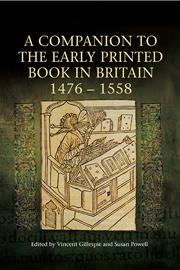Book contents
- Frontmatter
- Contents
- List of Illustrations
- List of Contributors
- Preface
- Acknowledgements
- Abbreviations
- Chronology of the Period
- Introduction
- I THE PRINTED BOOK TRADE
- II THE PRINTED BOOK AS ARTEFACT
- III PATRONS, PURCHASERS AND PRODUCTS
- 7 Merchants
- 8 The Laity
- 9 The Secular Clergy
- 10 The Regular Clergy
- 11 Universities, Colleges and Chantries
- IV THE CULTURAL CAPITAL OF PRINT
- Index of Manuscripts
- Index of Printed Books
- General Index
11 - Universities, Colleges and Chantries
from III - PATRONS, PURCHASERS AND PRODUCTS
Published online by Cambridge University Press: 05 April 2014
- Frontmatter
- Contents
- List of Illustrations
- List of Contributors
- Preface
- Acknowledgements
- Abbreviations
- Chronology of the Period
- Introduction
- I THE PRINTED BOOK TRADE
- II THE PRINTED BOOK AS ARTEFACT
- III PATRONS, PURCHASERS AND PRODUCTS
- 7 Merchants
- 8 The Laity
- 9 The Secular Clergy
- 10 The Regular Clergy
- 11 Universities, Colleges and Chantries
- IV THE CULTURAL CAPITAL OF PRINT
- Index of Manuscripts
- Index of Printed Books
- General Index
Summary
In 1517 work was begun on a new library-room at Eton College, a grander building for an expanding collection. Chains for the books were bought in three different lengths and the windows were stained with vignettes to signify the various suits of study that were laid out on the shelves below. The provost, Roger Lupton, is credited with the building, and he also gave books to the college, a mixed collection in manuscript and print. Eton has been fortunate: the building, now Election Hall, still stands; Lupton's books are still on College shelves. As such, they serve to remind us that when we come to draw our conclusions on the early circulation and impact of print we should be aware of a slant in the evidence, in that conclusions respective to one constituency or another are easier to make from surviving copies, and survival has favoured the higher secular clergy. The libraries of their colleges at Oxford and Cambridge, at Eton and Winchester, and chapter libraries at the secular cathedrals, more or less stable across the breach of the Reformation, have kept good numbers of books on their shelves, unlike the houses of regular clergy where losses were comprehensive. Where there are not the physical books there is often a substantial archive that can hold catalogues or inventories of the pre-Reformation collection, or there may be testamentary evidence concerning bequests of books to the library, or registers of benefactors. Of course, not every class of secular institution was so fortunate.
- Type
- Chapter
- Information
- A Companion to the Early Printed Book in Britain, 1476-1558 , pp. 207 - 224Publisher: Boydell & BrewerPrint publication year: 2014

